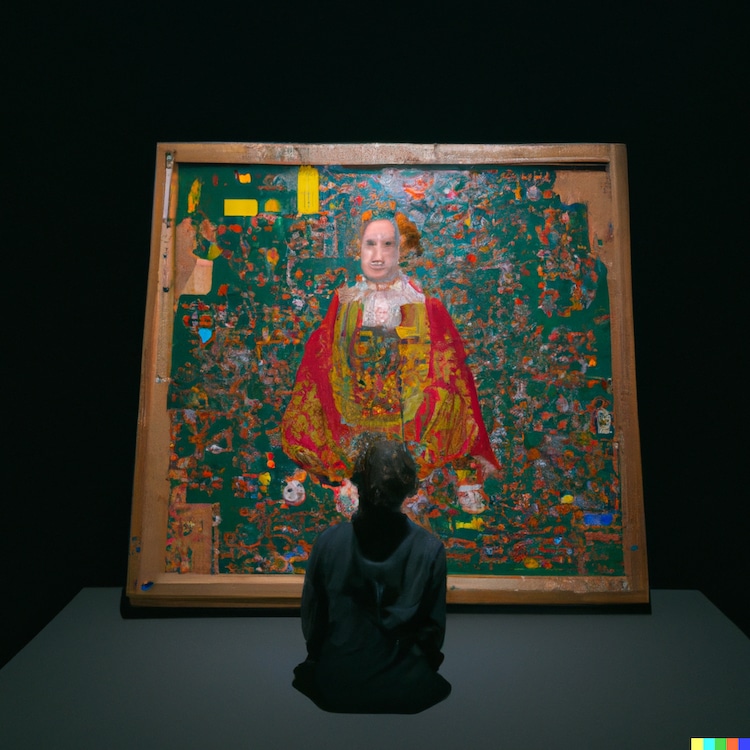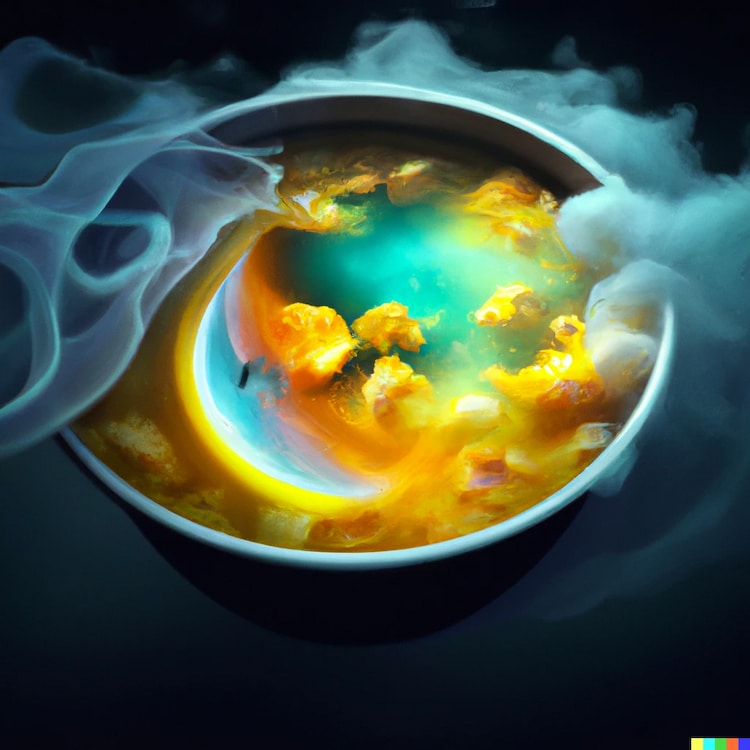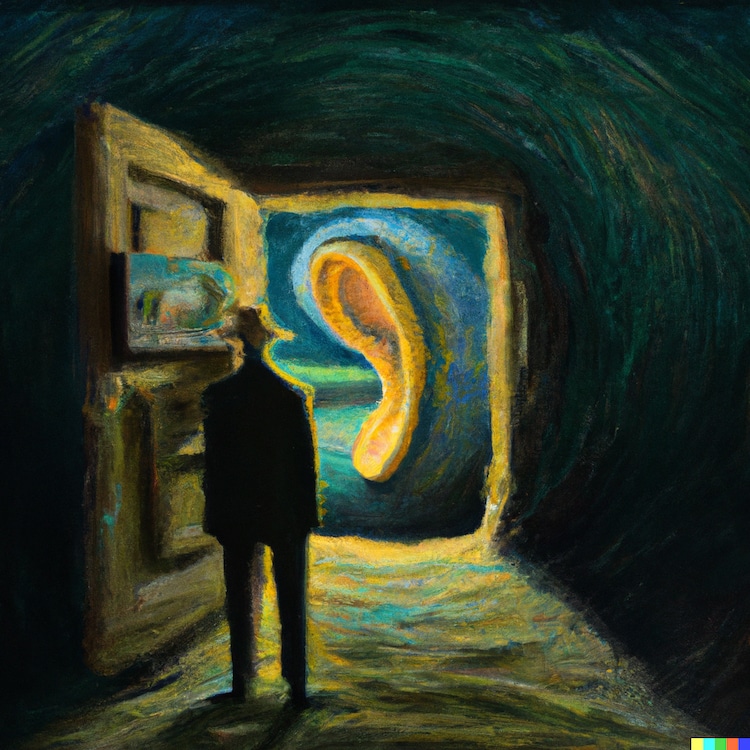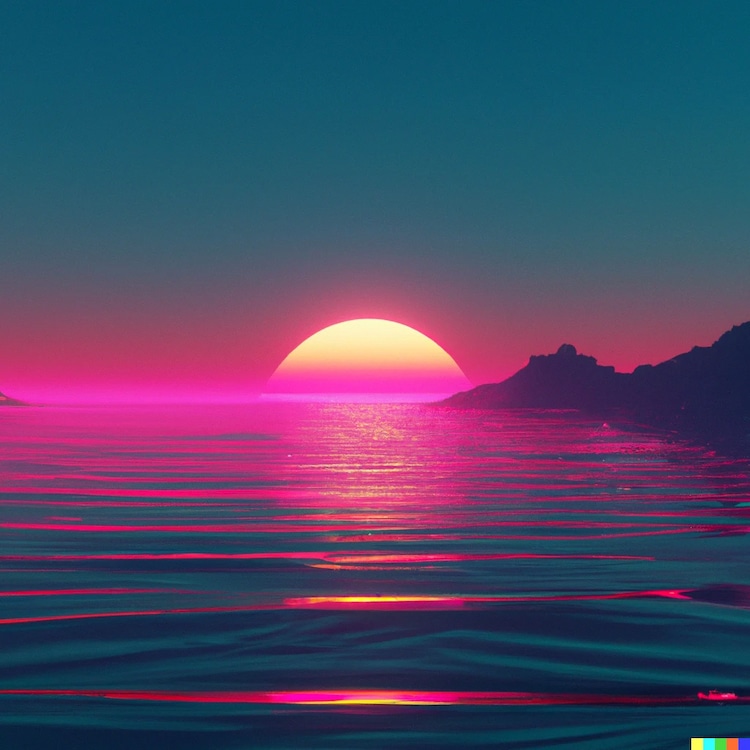Art Trend of 2022: How AI Art Emerged and Polarized the Art World

Photo: Image created with DALL•E
Artificial intelligence has been around for years, but AI-generated artwork has really taken off in 2022. With its growing presence and its rise in implementation, AI has proven to be a powerful yet controversial tool in the art world. Its use leads many to ask several questions: Is it art? Is it cheating? And who does the credit go to?
There's no doubt that AI is becoming increasingly more prevalent in the art world and beyond—these algorithmic concoctions are doing everything from winning art competitions to being the focus of exhibitions in distinguished museums like the MoMA. In an ever-changing world where technology is rapidly progressing and digital means are major vehicles for art, it makes sense that new ways of digital creation are formed. Whether the ethical implications are good or bad, AI-generated artwork is here and it’s on the rise.
AI art is still very much in its infancy in the mainstream, but there are several kinds of online communities for those that love to create it. From Instagram pages dedicated to sharing and challenging AI artists with creative prompts to small online forums and Discord channels, there is a lively place on the internet for those that enjoy the computerized art form.
We’ll take a look back on some of the most influential AI art tools of 2022 and the artists that use them. But first, it’s important to know what AI art really is and how AI began its trek in the art world.
What is AI artwork?
Artificial intelligence is the field of science which works to build machines that mimic human intelligence through algorithms. And simply put, AI artwork is any artwork created through the use of AI. AI artists work with the AI’s algorithms to create rules for how the machine analyzes images—sometimes thousands of images—to understand a certain creative process, such as an aesthetic or an art movement. Then, the AI generates shapes, forms, patterns, and figures to create something based on what it has learned.
Many AI art generators are text-to-image, meaning the rules that artists create are written prompts. These prompts can be simple, such as “a starry night sky,” or they can be very descriptive, like “a starry night sky full of constellations in the fall in the style of Claude Monet.” Artists can use other descriptors such as “telephoto” or “hyperrealistic” to create different results. Typically, they can also cycle through several versions the AI has created, expand the image, change the resolution, or have the AI redo its processing with the same prompt. And while anyone can use these generators, it takes time and practice to understand what words to use and how to use them in order to get a piece you want.

Photo: Image created with DALL•E
When did AI art begin?
AI artwork has its roots dated all the way back to the early conceptions of AI back in the 1800s and the advent of AI in the late 1950s. However, the creative application of AI really became its own in the 2010s. With advancements in AI technology involving how AI machines learn new concepts, a Google researcher named Alexander Mordvintsev was able to create the DeepDream algorithm in 2015 to study the way these complex computer neural systems learn visual concepts. With that, the floodgates were opened. Accessibility grows and open-source databases are more plentiful by the minute—and the application of these AI advancements form more and more AI art generators every day.

Photo: Image created with DALL•E
Why is AI artwork controversial?
The possibilities of AI are seemingly endless, and the application of this technology onto art is no exception. AI art generators have the power to be useful tools to those looking to hone their ideas, visualize complex ideations, and see where their inspirations lie. These generators also can break down somewhat mystifying barriers for people who do not possess the physical tools or crafting knowledge—democratizing the processes of art and allowing everyone to create. It's these powers that make AI artwork so polarizing, because what exactly is being created?
Because many of these AI art generators are open-sourced, these different forms of AI are using artworks scrapped from the internet and often without permission or proper credit. This means that everyone from Picasso to small, independent contemporary artists are not exempt from AI's analyzations. As well, if someone adds your name to their written prompt, your style will be hyper-analyzed and recreated to make something entirely new. Greg Rutkowski, a digital artist whose work has been in games like Dungeons & Dragons, was a favorite choice for many on both Stable Diffusion and Midjourney, and the resemblance between his works and AI generated works in his name can be pretty uncanny. This raises major concerns of everything from copyright issues to data protection, especially since artists typically cannot opt out of having their work analyzed and used. And while Rutkowski doesn't blame people for using his name, he says, “But for me and many other artists, it’s starting to look like a threat to our careers.”
Tom Mason, chief technology officer of Stability.AI, Stable Diffusion's developer, says, “Open-source AI is a tremendous innovation, and we appreciate that there are open questions and differing legal opinions. We expect them to be resolved over time, as AI becomes more ubiquitous and different groups come to a consensus as to how to balance individual rights and essential AI/ML research.” Mason continues, “We strive to find the balance between innovating and helping the community.”

Photo: Image created with DALL•E
Key Moments in the Rise of AI Art
The Quick Adoption of Midjourney
View this post on Instagram
Formed by a small team made up of researchers and experts from companies like NASA, Avid Technology, and Apple, Midjourney uses its own AI and a text-to-image generator to create fantastical pieces. Its system is accessed entirely through Discord. All users need to do is sign up for Midjourney’s Discord, head over to the right channel, and start typing “/imagine” followed by a prompt to create art. With over 4 million users since its release in July 2022, Midjourney's rise to popularity is an exponential one.
Architecture student Qasim Iqbal utilizes Midjourney to help him visualize his grand, fantastical architectural designs. “With Midjourney primarily being a text-to-image generator, it encourages you to summarize and define ideas through words and teaches you to be specific,” he tells My Modern Met. Iqbal specifies though, “I believe as a tool it offers me a way to test concepts, ideas, and directions for projects, but I do not think that one should rely on the tool to generate ideas. It could add but it should never be the originator of the idea.”
Midjourney: Website | Twitter | Discord
Qasim Iqbal/Studio MQI: Instagram
DALL·E 2 Is Used to Create the Cover of Cosmopolitan
View this post on Instagram
OpenAI‘s popular first iteration of DALL·E, named after Salvador Dalí and Pixar robot WALL-E, was released in 2021. Its highly anticipated DALL·E 2 was finally released in September 2022, with wide range of improvements: more realistic and accurate images, resolution improved by 400%, and preventions set in place to stop harmful images from being created. DALL·E 2 is another text-to-image generator, with some incredible results.
I used @OpenAI #dalle2 to create the first ever AI-generated magazine cover for @Cosmopolitan!! The prompt I used is at the end of the video #dalle pic.twitter.com/sbM2qbTAbq
— Karen X. Cheng (@karenxcheng) June 27, 2022
In June 2022, a small group of Cosmopolitan editors, OpenAI researchers, and digital artist and director Karen X. Cheng worked together for less than an hour to test out different written prompts to get a cover just right for the magazine. This cover, released June 21, 2022, is the first magazine cover ever to be designed by AI.
OpenAI: Website | DALL·E 2 | Twitter
Karen X. Cheng: Website | Instagram | Facebook | YouTube
AI Artwork Wins Art Competition
View this post on Instagram
Gaming company owner, Jason Allen, used Midjourney for 80 hours and pored over 900 images to create Théâtre D’opéra Spatial. Allen printed the piece on canvas and entered it into the Colorado State Fair's digital art category. After it won the blue ribbon in fall 2022, the news was posted online, which quickly sparked backlash. Artists felt slighted by the computer-generated piece taking the prize instead of non-AI works, and questions were raised as to if the judges were aware it was AI. Even though Allen says to have stated he used Midjourney to create the piece, at least one judge stated they did not know AI was used. This AI art win in a competition against non-AI works sparked fervent debates on whether Allen's hours of tweaking are equatable to physical creation of art.
NightCafe's Democratization of Art
View this post on Instagram
While AI artists awaited the return of DALL·E in the form of DALL·E 2, other AI art generators also became more popular. Enter Angus Russell's NightCafe Creator, launched in 2019 and named after Vincent Van Gogh's The Night Cafe. NightCafe Studio states, “we create tools that allow anyone—regardless of skill level—to experience the satisfaction, the therapy, the rush of creating incredible, unique art.” The team is dedicated to providing access to art creation to all, not to “make artists redundant.” Through online forums and their site's blog, NightCafe Studio teaches people the ins and outs of using AI art generators. In response to DALL·E's success, in February 2022, they interviewed artist zenElan for his secrets to creating fantastical works.
Previously a photographer, zenElan now creates otherworldly artworks using NightCafe Creator. He's inspired by the process of “discovery and re-discovery” that goes alongside AI art and tells novice AI artists, “If you want to go deeper recognize that you have an incredibly powerful tool in front of you.” As for zenElan's opinion about AI art's role in society, he's less sure. “I think we're all learning as we go and how it fits within a larger context,” he says. “It brings people back together by renewing that sense of wonder the internet had before social media, thought maintains the element of sharing and community.”
NightCafe Studio: Website | NightCafe Creator | Twitter | Reddit | Instagram
zenElan: NightCafe Creator Profile | Instagram | Twitter | ArtPal
MoMA Exhibit Features AI Art Installation
I’m deeply honored and excited to announce our exhibition — Unsupervised opening on the 19th of November at MoMA! It’s a dream of many artists to have the opportunity to imagine, practice and exhibit for such an important institution that supports the creativity of humanity! pic.twitter.com/OR25D7wrYJ
— Refik Anadol (@refikanadol) November 4, 2022
The Museum of Modern Art's Refik Anadol: Unsupervised uses AI—created by Anadol himself—that analyzes 380,000 images of 180,000 art pieces from MoMA's collection to create a continuous stream of moving images. MoMA describes the giant 24 feet by 24 feet piece as, “a singular and unprecedented meditation on technology, creativity, and modern art.” The installation seeks “to interpret and transform more than 200 years of art from MoMA’s collection.” Unlike Andol's first Unsupervised, posted to Feral File in 2021, his MoMA piece also responds to real-time environmental inputs, like light, sound, and movement. As the museum states, “The history of modern art will be transformed by the liveness of public space in the present.” Refik Anadol: Unsupervised will be showing from November 19, 2022 to March 5, 2023, and marks a historic moment for the museum and the exhibiting art world at large.
MoMA: Website | Instagram | Twitter
Refik Anadol: MoMA Installation | Website | Instagram | Twitter | Behance
AI Art Generators Pop Up All Over Social Media
View this post on Instagram
Some AI art generators—like NewProfilePic and the recently popular Lensa with its Magic Avatar feature—have allowed anyone to turn their selfies into highly stylized artworks that look like they belong in a museum or on a movie poster. This has been a fun intersection of art, photography, and social media for the public, but it has also led to the realization of a much larger problem. As a number of artists have spoken up, it has become more and more clear that artificial intelligence is learning and essentially stealing signature styles of artists around the world. The AI generators pull data from billions of images across the internet. So long as an artist uploads their work online, it can be “studied” and “learned” by AI and then mimicked.
Seeing plenty of thoughts online about the future of digital art in connection with AI generations, we decided to share some information on how AI generates images and why it will not replace digital artists. 🧵🧵🧵
— Prisma Labs (@PrismaAI) December 6, 2022
Lensa's parent company, Prisma, has quickly responded to growing concerns about AI taking jobs away from human artists. The company maintains that AI is not the end of art, but rather an evolution and extension of it. In a Twitter thread, Prisma writes, “As cinema didn't kill theater and accounting software hasn't eradicated the profession, AI won't replace artists but can become a great assisting tool.”
The AI learns to recognize the connections between the images and their descriptions, not the artworks. This way the model develops operational principles that can be applied to content generation. Hence the outputs can't be described as exact replicas of any particular artwork
— Prisma Labs (@PrismaAI) December 6, 2022
It takes at least 10 minutes for the machine to make approx. 120 million billion (yes, it's not a typo) mathematical operations every time, meaning we have a separate model for each user, not a one-size-fits-all monstrous neural network trained to reproduce any face.
— Prisma Labs (@PrismaAI) December 6, 2022
To sum up,AI produces unique images based on the principles derived from data, but it can't ideate and imagine things on its own. As cinema didn't kill theater and accounting software hasn't eradicated the profession, AI won't replace artists but can become a great assisting tool
— Prisma Labs (@PrismaAI) December 6, 2022
We also believe that the growing accessibility of AI-powered tools would only make man-made art in its creative excellence more valued and appreciated, since any industrialization brings more value to handcrafted works.
— Prisma Labs (@PrismaAI) December 6, 2022
Related Articles:
Popular App Will Transform Your Selfie Into an Artsy Avatar, But It Comes With a Warning
9 AI-Generated Artworks Create the ‘Mona Lisa’ That Is Only Revealed When Put Together
Artist Hides AI Faces Within Densely Patterned Paintings
Dreamy Landscapes Accented With Glowing Lights Inspire Relaxation
READ: Art Trend of 2022: How AI Art Emerged and Polarized the Art World
0 Commentaires